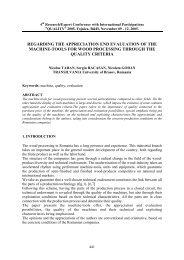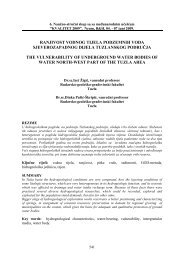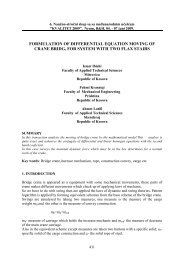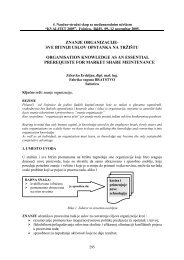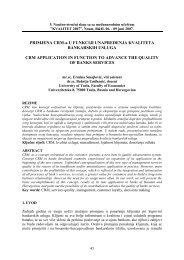Modern Approaches of the Educational Programs Quality Design
Modern Approaches of the Educational Programs Quality Design
Modern Approaches of the Educational Programs Quality Design
Create successful ePaper yourself
Turn your PDF publications into a flip-book with our unique Google optimized e-Paper software.
6 th Research /Expert Conference with International Participations<br />
“QUALITY 2009”, Neum, B&H, June 04-07, 2009<br />
MODERN APPROACHES TO QUALITY EDUCATIONAL<br />
PROGRAMMES DESIGN<br />
Nikolay S. Popov<br />
Tambov State Technical University<br />
Tambov<br />
Russia<br />
Sergey V. Mischenko<br />
Tambov State Technical University<br />
Tambov<br />
Russia<br />
Lilia A. Mozerova<br />
Tambov State Technical University<br />
Tambov<br />
Russia<br />
SUMMARY<br />
Reserves for improvement <strong>of</strong> university graduates training quality are presented in <strong>the</strong><br />
recommendations which had been introduced in Europe in <strong>the</strong> frames <strong>of</strong> <strong>the</strong> Bologna Process<br />
development. Academic quality <strong>of</strong> education depends on quality <strong>of</strong> staff activities and quality <strong>of</strong><br />
educational programs. Tambov State Technical University in <strong>the</strong> consortium with partner universities<br />
from Italy, Spain, Slovak Republic and Udmurt Republic in 2008 has realized <strong>the</strong> TEMPUS project<br />
where had been used modern approaches and technologies <strong>of</strong> “Master in Environmental Law and<br />
Policies in <strong>the</strong> Russian Federation” program design: competence model <strong>of</strong> graduate, threedimensional<br />
model <strong>of</strong> content organization, credit system <strong>of</strong> program evaluation, training orientation<br />
to <strong>the</strong> sustainable development, etc. The paper includes <strong>the</strong> analysis <strong>of</strong> all above mentioned<br />
components contribution to <strong>the</strong> final result - masters training quality.<br />
Key words: Bologna process, quality <strong>of</strong> training, TEMPUS program<br />
1. INTRODUCTION<br />
National higher education system has been developing according to <strong>the</strong> global processes,<br />
tendencies and demands <strong>of</strong> <strong>the</strong> world labour market. Solving <strong>the</strong> problems <strong>of</strong> reforming<br />
higher education institutions in Russia it has become impossible to take into account only <strong>the</strong><br />
national level criteria. Today universities should be able to prepare qualified specialists<br />
meeting <strong>the</strong> requirements <strong>of</strong> <strong>the</strong> modern society and to provide <strong>the</strong> stable development <strong>of</strong> <strong>the</strong><br />
country. Fundamental changes which happened in all spheres <strong>of</strong> <strong>the</strong> society life-economic,<br />
political, social – determine changes in <strong>the</strong> higher education system.<br />
The quality enhancement <strong>of</strong> university graduates training is <strong>the</strong> actual problem for all<br />
international educational environment and all <strong>the</strong> stakeholders including employers and<br />
students are interested in this process development. According to <strong>the</strong> UNESCO document<br />
“Policy Paper for Change and Development in Higher Education” accepted in 1995, <strong>the</strong>re are<br />
617
three main criteria <strong>of</strong> educational activity: staff quality, educational programme quality and<br />
quality <strong>of</strong> infrastructure embracing its functions [1].<br />
Staff qualification and educational programmes quality combined with scientific research<br />
determine academic education quality. Higher education quality assurance recommendations<br />
adopted by <strong>the</strong> European Parliament and European Council in 1998 exhort EU countries to<br />
introduce quality assurance systems according to <strong>the</strong> standards and recommendations<br />
developed in <strong>the</strong> frames <strong>of</strong> <strong>the</strong> Bologna process (“European Standards and Guidelines for<br />
<strong>Quality</strong> Assurance in Higher Education” 2005). Obviously, quality is a key to <strong>the</strong> European<br />
higher education area.<br />
2. EDUCATION QUALITY CONTROL IN RUSSIA<br />
Education quality control in Russia is carried out by <strong>the</strong> following processes:<br />
- licensing – assessment <strong>of</strong> conformity <strong>of</strong> <strong>the</strong> conditions <strong>of</strong> implementation <strong>of</strong> educational<br />
process with <strong>the</strong> state and local requirements regarding norms and rules, sanitary and<br />
hygienic norms, health protection <strong>of</strong> learners, <strong>the</strong> equipment <strong>of</strong> educational premises,<br />
equipment <strong>of</strong> educational process, <strong>the</strong> educational qualification <strong>of</strong> pedagogical staff, etc.;<br />
- certification – assessment <strong>of</strong> conformity <strong>of</strong> <strong>the</strong> content, a level and quality <strong>of</strong> training <strong>of</strong><br />
graduates to requirements <strong>of</strong> <strong>the</strong> state educational standard;<br />
- public accreditation –establishment <strong>of</strong> <strong>the</strong> state status <strong>of</strong> <strong>the</strong> educational institution;<br />
- development, implementation and certification <strong>of</strong> university quality management system<br />
according to <strong>the</strong> standards ISO 9000: 2000 (GOST R ISO 2000-2001).<br />
There are some problems which should be solved by <strong>the</strong> universities immediately. They are:<br />
development <strong>of</strong> two-level programs (Bachelor and Master) harmonized with those <strong>of</strong><br />
European education and having <strong>the</strong> substantial quality, as Russia signed <strong>the</strong> Bologna<br />
Declaration in 2003. The experience <strong>of</strong> such programs development can be acquired as a<br />
result <strong>of</strong> universities international cooperation.<br />
Such cooperation is presented in this article. In 2005-2008 Tambov State Technical<br />
University (TSTU) was realizing TEMPUS-TACIS project “Master in Environmental Law<br />
and Policy in Russian Federation” in cooperation with <strong>the</strong> University <strong>of</strong> Genoa (Italy),<br />
University <strong>of</strong> Alicante (Spain), Slovak University <strong>of</strong> Technology in Bratislava and Udmurt<br />
State University. This project was financed by European Commission.[2]<br />
The objectives <strong>of</strong> this project were: developing a new Master program in <strong>the</strong> international<br />
consortium <strong>of</strong> universities, applying EU standards to teaching Environmental Law and<br />
Policies in <strong>the</strong> RF universities, setting up a documentation centre for training new Masters for<br />
<strong>the</strong> sustainable development <strong>of</strong> nature and society. The program development was based on<br />
four approaches: legal, political, economic and social (Fig. 1).<br />
618
Political<br />
Decisions Legal<br />
Decisions<br />
Process <strong>of</strong> Planning<br />
Sustainable Development Concept<br />
Decision-Making Process<br />
Economic<br />
Decisions<br />
Engineering and<br />
Environmental<br />
Decisions<br />
Methodological Framework<br />
<strong>of</strong> Planning and Management<br />
Objectives Realization<br />
Theory <strong>of</strong> Environmental and Manufacturing Systems<br />
Figure 1. Integrated <strong>Educational</strong> Program Structure<br />
Social<br />
Decisions<br />
This education programme can be considered an innovative and problem-oriented because it<br />
is connected with <strong>the</strong> sustainable development concept (RIO-92). It is based on <strong>the</strong> following<br />
Bologna declaration main points:<br />
- adoption <strong>of</strong> a system <strong>of</strong> easily readable and comparable degrees;<br />
- adoption <strong>of</strong> a system with two main cycles (undergraduate/graduate);<br />
- establishment <strong>of</strong> a system <strong>of</strong> credits (such as ECTS);<br />
- promotion <strong>of</strong> mobility by overcoming obstacles;<br />
- promotion <strong>of</strong> European cooperation in quality assurance;<br />
- promotion <strong>of</strong> European dimensions in higher education.<br />
The external experts <strong>of</strong> <strong>the</strong> project are representatives <strong>of</strong> Ministry <strong>of</strong> Natural Resources and<br />
Ecology <strong>of</strong> RF, Department <strong>of</strong> Nature Management and Environment Protection <strong>of</strong> <strong>the</strong><br />
Tambov Region and Federal Service for Education and Research Supervision.<br />
Business circles were presented by ARPA Piemonte, (Piemont Regional Agency for<br />
Environmental Protection, Italy, (Turin) and Association "Europa Liguria Mediterraneo",<br />
Italy ( Genoa). They acted in <strong>the</strong> field <strong>of</strong> programme evaluation and monitoring, gave<br />
recommendations in programme contents, determined <strong>the</strong> admission criteria, assessed quality<br />
<strong>of</strong> <strong>the</strong> training programme, evaluated dissertation <strong>the</strong>ses.<br />
During <strong>the</strong> project activities <strong>the</strong> technology <strong>of</strong> programme development was defined:<br />
1. Programme mission determination.<br />
2. Labour market analysis and competences definition.<br />
3. Curriculum making.<br />
4. Modules development and textbooks writing.<br />
5. Documentation centre establishment as a resource for teaching process.<br />
6. Exchange <strong>of</strong> ideas with o<strong>the</strong>r universities and scientists with <strong>the</strong> help <strong>of</strong> INTERNET<br />
technologies.<br />
7. Transfer <strong>of</strong> <strong>the</strong>oretical knowledge to practical skills.<br />
8. Vision <strong>of</strong> <strong>the</strong> programme.<br />
619
It was settled to determine <strong>the</strong> educational programme not only as teaching materials,<br />
timetable and textbooks but also <strong>the</strong> technology <strong>of</strong> teaching students and methods <strong>of</strong> quality<br />
assurance (Fig.2).<br />
Competences<br />
Instrumental<br />
Interpersonal<br />
Systemic<br />
Special<br />
Technology <strong>of</strong><br />
Content <strong>Design</strong><br />
Control System<br />
Training<br />
Technology<br />
Figure 2. <strong>Educational</strong> Programme Content<br />
<strong>Educational</strong> Program<br />
Content<br />
Lectures<br />
Practices<br />
Laboratory Works<br />
Individual Work<br />
The specific features <strong>of</strong> <strong>the</strong> programme are:<br />
• student – centered approach using;<br />
• subject choice opportunity and individual programme making due to electives.<br />
The student centered approach means that <strong>the</strong> key knowledge and skills that a student needs<br />
to achieve during <strong>the</strong> learning process determine <strong>the</strong> content <strong>of</strong> <strong>the</strong> study programme. This<br />
approach was used in combination with G. Polya <strong>the</strong>ory [3], which determines 4 phases<br />
cognitive activity: mobilization, organization, isolation, combination. . All <strong>of</strong> <strong>the</strong>m are<br />
described in <strong>the</strong> table below.<br />
Polya model<br />
elements<br />
Mobilization Goals, volume and<br />
information character<br />
Organization<br />
definition to remember<br />
Definition <strong>of</strong> <strong>the</strong> core<br />
notions and <strong>the</strong>ir<br />
Isolation<br />
connection with previous<br />
information.<br />
Limits to glossary to<br />
understand.<br />
Definition <strong>of</strong> working<br />
phases, choice <strong>of</strong> goal<br />
achieving algorithm.<br />
Combination Receiving new<br />
knowledge in discipline;<br />
own cognitive<br />
possibilities; reasons <strong>of</strong><br />
problems.<br />
Student activity Teacher activity<br />
620<br />
Requirements to activity determined by<br />
education standard.<br />
Teaching students to work with matrix<br />
and graph models.<br />
Teaching general and subject skills, selfassessment.<br />
Teaching to analyze own learning<br />
activity, reflection.
The project work is structured on Figure 3.<br />
Consortium <strong>of</strong><br />
Universities from:<br />
• Genoa<br />
• Alicante<br />
• Bratislava<br />
Curricula<br />
Submission<br />
Department <strong>of</strong> Nature<br />
Management and<br />
Environment Protection<br />
Module 1<br />
Mechanical<br />
Engineering -<br />
Faculty<br />
Technical<br />
Secretary<br />
Program Council<br />
Program Coordinators<br />
Coordinator<br />
Assistant<br />
TSTU Financial<br />
Service<br />
Master Program<br />
«Environmental Law and<br />
Policies»<br />
Module 2<br />
Mechanical<br />
Engineering<br />
Faculty<br />
………….<br />
Special Disciplines Cluster<br />
Figure 3. Scheme <strong>of</strong> Project Work<br />
Project Web site<br />
and On-line<br />
Journal<br />
Universities<br />
Forum<br />
Curricula Corrections<br />
Federal Service for<br />
Education and<br />
Research Supervision<br />
Module 12<br />
Faculty <strong>of</strong><br />
Economics<br />
Competence model <strong>of</strong> master student in environmental law and policy was developed<br />
according to requirements <strong>of</strong> <strong>the</strong> Russian labour market and international consortium<br />
teachers’ experience. Taking into account <strong>the</strong> materials <strong>of</strong> <strong>the</strong> project “Tuning <strong>Educational</strong><br />
Structures in Europe” [4] four competence groups were formed: instrumental, interpersonal,<br />
systemic and special. The teaching methods were determined as well as <strong>the</strong> control tools.<br />
In <strong>the</strong> course <strong>of</strong> this activity <strong>the</strong> algorithm <strong>of</strong> academic workload calculation was introduced<br />
(Fig.4) with <strong>the</strong> quantitative characteristics <strong>of</strong> <strong>the</strong> educational program: <strong>the</strong> program took 2<br />
years, 4 semesters, weeks in 1 st and 3 rd semesters – 18, in 2 nd and 4 th semesters – 22 weeks.<br />
Academic year included 40 weeks. Week workload was 45 hours, semester workload – 1800<br />
hours corresponded to 60 ECTS (1 ECTS=30 hours).<br />
Course<br />
Objectives<br />
Calculation <strong>of</strong><br />
Learning Time<br />
Algorithm <strong>of</strong> Workload<br />
Calculation<br />
Course<br />
Contents<br />
• Lectures<br />
• Practices<br />
• Seminars<br />
Workload (in hours)<br />
Course<br />
Structure<br />
Course<br />
Program<br />
Time Distribution According to Teaching Activities<br />
Figure 4. Algorithm <strong>of</strong> Workload Calculation<br />
621
Competence model <strong>of</strong> Master reflected <strong>the</strong> disciplines contents. The following first year<br />
modules were introduced:<br />
1. Economics <strong>of</strong> sustainable development.<br />
2. Environment quality evaluation and control.<br />
3. Environmental governance.<br />
4. European environmental law.<br />
5. Administrative law and regulatory agencies on environmental issues.<br />
6. Ecology and environmental sciences.<br />
Modules <strong>of</strong> <strong>the</strong> second year:<br />
1. Module. Comparative economics <strong>of</strong> environmental welfare.<br />
2. Module. Comparative politics <strong>of</strong> environmental government.<br />
3. Module. Environmental policy processes.<br />
4. Module. Comparative environmental law and law making.<br />
5. Module. <strong>Quality</strong> <strong>of</strong> legislative systems on environmental issues.<br />
6. Module. Watershed management and protection.<br />
The module format <strong>of</strong> Master programme allows organizing flexible learning in consequential<br />
and parallel modes depending on student requirements (study abroad, distance learning, etc.).<br />
Textbooks contents were developed based on three-dimensional model (T-model) <strong>of</strong><br />
Reigeluth C.M. and Curtis R.V. [5]. All in all twelve textbooks were written, six <strong>of</strong> <strong>the</strong>m were<br />
published.<br />
The new Master programme started in TSTU in 2006. The group <strong>of</strong> 15 students was enrolled<br />
on a competitive basis, most <strong>of</strong> <strong>the</strong>m with <strong>the</strong> Bachelor diploma in “Engineering Protection <strong>of</strong><br />
Environment”. 13 students successfully defended <strong>the</strong>ir Master <strong>the</strong>ses on topics connected with<br />
<strong>the</strong> sustainable development <strong>of</strong> economic development <strong>of</strong> <strong>the</strong> region.<br />
The implementation <strong>of</strong> <strong>the</strong> programme was very successful. All <strong>the</strong> programme graduates<br />
found <strong>the</strong>ir jobs. The university had a positive feedback from employers. External experts<br />
noted <strong>the</strong> fruitful cooperation in <strong>the</strong> frames <strong>of</strong> university consortium. Now TSTU is intended<br />
to transfer its experience <strong>of</strong> Master programme design to o<strong>the</strong>r universities.<br />
3. REFERENCES<br />
[1] World Declaration on Higher Education for <strong>the</strong> Twenty-First Century: Vision and Action.<br />
World conference on higher education, Paris, October 9, 1998.<br />
[2] http://frelp.web.tstu.ru<br />
[3] “Tuning <strong>Educational</strong> Structures in Europe. Universities contribution to <strong>the</strong> Bologna process.”<br />
Final Report. Publication <strong>of</strong> <strong>the</strong> University Deusto, 2005.<br />
[4] Polya G.. Ma<strong>the</strong>matical Discovery. M, Nauka, 1970 – 452 p.<br />
[5] Reigeluth C.M., Curtis R.V. Learning Situations and Instructional Models. In: Gagne R.M. (Ed),<br />
Instructional Technology: Foundations. Hillsdale, New Jersey, London: Lawrence Erlbaum<br />
Associates Publishers, p.175-205 (1987).<br />
622



